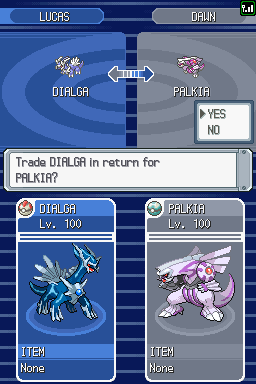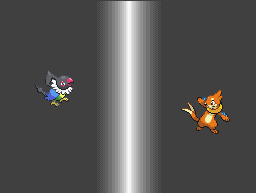Trade

A trade is a process in which Pokémon Trainer sends one of his or her Pokémon to another trainer in exchange for one of the other trainer's Pokémon. In every Pokémon game, trading is necessary to collect all Pokémon.
Starting from Generation II, items can be attached to Pokémon when traded. Certain items, when held by the correct Pokémon, will trigger an evolution when traded to another player. Mail may also be attached to send a message.
Benefits of trading

Trading is necessary in order to collect every Pokémon in the Pokédex, as some Pokémon aren't available in each edition. For example, Meowth cannot be found in Pokémon Red, and the player must trade with someone who has a copy of Pokémon Blue. Some Pokémon only evolve after being traded. Trading away a Pokémon will not remove its Pokédex entry.
Traded Pokémon gain 1.5x the normal experience after a Pokémon battle. Pokémon traded from another country will gain 1.7x experience.
Trading may also be used to transfer additional instances of limited and rare items, such as Master Balls or Soul Dews, from one game to another by making a Pokémon hold them.
Drawbacks of trading
A traded Pokémon is referred to as an outsider Pokémon, and will only obey a trainer with the sufficient number of gym badges. In addition, a traded Pokémon's nickname cannot be changed except if traded back to the original trainer. Even if a Pokémon wasn't given a nickname by its original trainer, then the trainer to whom it was traded still cannot change its name.
Traded Pokémon are identified by the Pokémon's Original Trainer name and a five-digit ID Number. Even if two games have the same name and ID number, each trainer also has a secret ID number. The odds of two trainers having different secret ID numbers is 99.998%, making it extremely unlikely that an outsider Pokémon will be treated as a regular Pokémon on a different cartridge.
Limitations on trading
Trading between game generations
Trading between different generations of Pokémon is possible, with two major limitations: trading between Generation II (GB/GBC) and Generation III (GBA) is impossible, and trading from Generation III (GBA) to Generation IV (DS) is one-way only.
Pokémon can be traded from Generation II back to Generation I games using the Time Capsule feature. For compatibility purposes, the Pokémon to be traded cannot have any attacks which do not exist in Generation I.
Pokémon can be transferred from Generation III to Generation IV using the Pal Park feature. However, they cannot be traded in the opposite direction.
Trading from Generations I and II to Generation III is impossible for two reasons. Firstly, hardware reasons prevent a GBA game from linking to a Gameboy Color game. Secondly, the Pokémon data structure was changed significantly, and the two are no longer compatible. Likewise, the Nintendo DS has no link cable support. Enterprising players may use a cheating tool such as Pokésav to re-create their Pokémon in Generation IV.
International trading
Trading between two different regional Pokémon cartridges wasn't possible in Generation I and Generation II due to the differences between the languages and character sets. Any attempts to trade between the different regional catridges would result in corruption of the save files, forcing the player to restart their game from scratch.[1] Trades between UK English versions and American English versions were also impossible due different codings for the character sets.
International trading became possible in Generation III, however, only through wireless adapters or link cables due to the lack of Wi-Fi, though the Pokémon would not maintain their names in their original languages once traded over to Japanese versions due to the restrictions of spaces for the nicknames. This is due to restrictions in the Japanese versions of games, including Pokémon, where it is allowed only five spaces for nicknaming any Pokémon caught in the games while the western versions allow ten spaces. Thus, trades between different regional games wasn't so common during this point of time. This feature however expanded in Generation IV after the release of Pokémon Diamond and Pearl for the Nintendo DS, where Wi-Fi was finally available and the space restriction was lifted.
The Nintendo DS Pokémon games fully support international trading, including Internet trading via the Global Trade Station in Jubilife City. Pokémon from Korean games, however, do not retain their original names in Hangul when traded to other language versions.
Hardware requirements
Trading requires two game consoles and two copies of the game. Nintendo's intention is that players trade with friends, although some serious players purchase two consoles and two copies of the game.
Prior to Generation IV (Nintendo DS), trading required a Game Boy link cable, or a GBA Wireless Adapter (Generation III). Although the Nintendo DS supports Generation III (GBA) games, it cannot be used to trade between those games as the DS lacks hardware support for the link cable.
The Pal Park feature of Generation IV games uses the GBA slot of the Nintendo DS, so unlike other trading requires only one game console. However, it is not compatible with the Nintendo DSi, which does not have a GBA slot.
Requirements for trading
Generation I
The player cannot trade Pokémon before getting a Pokédex from Professor Oak at Pallet Town.
Generation II
The player cannot trade Pokémon before transporting the Mystery Egg to Professor Elm. The Time Capsule cannot be used until the player has met Bill at Ecruteak City's Pokémon Center, and waiting until the next day when setup is completed.
Generation III
Ruby, Sapphire, and Emerald Versions
The player cannot trade Pokémon before getting a Pokédex from Professor Birch at Littleroot Town. To trade, the player must have at least two Pokémon in the party. In Emerald, trading with Pokémon FireRed and LeafGreen is prohibited unless the National Dex has been obtained, while trading with FireRed and LeafGreen in Ruby and Sapphire will itself activate the National Dex automatically.
FireRed and LeafGreen Versions
The player cannot trade Pokémon before getting a Pokédex from Professor Oak at Pallet Town. The player must have at least two Pokémon in the party in order to trade. Trades with Ruby, Sapphire and Emerald are possible only after bringing Ruby and Sapphire to complete Celio's Network Machine, which can be done only after the player has become the champion and obtained the National Dex.
Pokémon Colosseum and Pokémon XD
The player cannot trade Pokémon with the GBA games until they has beaten Cipher Head (Evice in Pokémon Colosseum of the game and Grand Master Greevil in Pokémon XD). Also, trading any unpurified Shadow Pokémon is completely prohibited, as data for Shadow moves doesn't exist in the GBA games, and Colosseum only has data for the move Shadow Rush.
Generation IV
Diamond, Pearl, and Platinum Versions
The player cannot trade Pokémon before getting a Pokédex from Professor Rowan at Sandgem Town. Also, the player has to have at least two Pokémon in the party. Migrating Pokémon from the Generation III games through Pal Park cannot be done until the National Pokédex has been obtained. In Platinum, the player is now able to press B to select the "CANCEL" button.
My Pokémon Ranch
Hayley will only offer to trade with the player after they have completed a wanted request, and will only trade specific Pokémon and only if she has already brought one of them to the Ranch.
HeartGold and SoulSilver Versions
Similar to Diamond, Pearl, and Platinum, trading cannot occur until the player has obtained his or her Pokédex from Professor Oak at Mr. Pokémon's house. The player must have at least two Pokémon in the party; but no additional prerequisite is needed to trade with the Sinnoh games: this can be done at the very beginning of the game. Migrating Pokémon from Generation III games through Pal Park is also possible later in the game if the player has a Nintendo DS or DS Lite. This is the only game so far that allows trading between 2 different regions without first obtaining a National Dex.
Pokémon which evolve when traded
Many of these Pokémon also require an item to be held by them at the time of trading for their evolution to take place.
From Generation I
From Generation II
- Poliwhirl → Politoed (if King's Rock is held)
- Slowpoke → Slowking (if King's Rock is held)
- Onix → Steelix (if Metal Coat is held)
- Seadra → Kingdra (if Dragon Scale is held)
- Scyther → Scizor (if Metal Coat is held)
- Porygon → Porygon2 (if Up-Grade is held)
From Generation III
- Clamperl → Huntail (if DeepSeaTooth is held)
- Clamperl → Gorebyss (if DeepSeaScale is held)
From Generation IV
- Rhydon → Rhyperior (if Protector is held)
- Electabuzz → Electivire (if Electirizer is held)
- Magmar → Magmortar (if Magmarizer is held)
- Porygon2 → Porygon-Z (if Dubious Disc is held)
- Dusclops → Dusknoir (if Reaper Cloth is held)
See also
Trades in the anime
Despite it being one of the key aspects of the games, trading is unusually rare in the anime. Only a few trades have taken place, and only four of them thus far have been truly significant. Fans have often speculated about the reason for this. Rather than simply exchanging Pokémon, most trades are carried out by placing Poké Balls into a specialized trading machine, with a monitor that displays silhouettes of the two Pokémon as they pass each other.
- In Battle Aboard the St. Anne, Ash traded his Butterfree for a Gentleman's Raticate. He wasn't happy with the trade, however, so he traded it back by the end of the episode.
- In Tricks of the Trade, Jessie unintentionally traded her Lickitung for Benny's Wobbuffet.
- In Here's Lookin' at You, Elekid, James is forced by Jessie to trade his Victreebel for the Magikarp salesman's Weepinbell.
- In Throwing the Track Switch, Ash traded his Aipom for Dawn's Buizel.
The trade machine used in the anime has seemingly been adapted into the game canon, with Professor Oak's laboratory in both Template:En and Pokémon Stadium 2 having this type of machine for trades. In the same way, when link cables were finally able to accept the data of two Pokémon being sent at once (rather than one at a time as in Generations I and II), the Pokémon are shown passing each other in the link space.
Trivia
- Trading was one of the core design elements of the original Pokémon Red and Green Versions. Satoshi Tajiri stated that if the games could not communicate with each other, his vision for the Pokémon games would be incomplete. (「別のソフトとの間で通信を行わないとポケモン図鑑が完成しない」)
- In Pokémon Red and Blue there is a Scientist at the Pokémon Lab in Cinnabar Island that would trade a Raichu for an Electrode. If the player talked to him after the trade, he would mention that the Raichu evolved, which is not possible. This mistake, which was due to the original translation of the Japanese Blue's script, was corrected in Pokémon FireRed and LeafGreen.
- Likewise, if the player traded a Raichu under level 30, the player will receive a Electrode, yet underleveled.
- Every trade in the anime that involves a main character has resulted in at least one of the traded Pokémon later being released, except for the trade between Benny and Jessie.
- Porygon is the only Pokémon to evolve twice via trading.
- In addition, Porygon2 is the only Pokémon to have evolved from trading that can evolve further.
- Clamperl is the only Pokémon that can evolve into one of two Pokémon where both evolutions are achieved by trading.
| Pokémon training | |
|---|---|
| Catching • Nicknaming • Battling • Evolving • Trading • Breeding • Releasing | |
